New to Snowshoeing and X-Country Skiing? No Problem!
New to showshoeing and X-Country Skiing? No Problem!
Find the right gear and splendid beginner-friendly terrain
This is the year you're going to embrace winter! You're going to get out into the snow and show Mother Nature that you dig what she does all year long! You're going to do it!
If only you knew where to start.
 While snowshoeing looks fairly simple, you can’t help but wonder if there’s a special trick to it. Is it hard? Do you need a lesson? Where’s a nice flat place for a beginner to roam?
While snowshoeing looks fairly simple, you can’t help but wonder if there’s a special trick to it. Is it hard? Do you need a lesson? Where’s a nice flat place for a beginner to roam?
And sure, cross-country skiing seems awesome based on all those photos you see on Facebook, but it also looks like something you're not sure you can do. Do you have to be super fit? How do you even get up after you fall down with those long sticks stuck on your feet? (Because you're 100 percent sure you're going to fall down, and you really don’t want to be that person who needs to call in a rescue squad to help them get upright again.)

These are the questions that tend to trip us up, figuratively speaking, and keep us from trying new things. But we’ve got some guidance that’ll help move you from “I’d love to try it” to “I did it and it was awesome!" Once you get a taste of how excellent it is to wander through a winter snowscape, in snowshoes or on skis, you’ll want to be out there all the time. These are also wonderful ways to stay active in the winter and create family-friendly experiences in the outdoors, where you can scout for animal tracks or have a picnic in the snow to make it even more memorable and fun.
It also helps to remember that everyone out there began as a beginner. Every snowshoer and every swift skier you see had their first time, too. Before you know it, you’ll be the cool winter adventurer sharing photos of your snow-covered exploits.
Snowshoeing Snowshoeing in particular is an extremely beginner-friendly activity. If you can walk, you can most likely snowshoe perfectly well right out of the gate. Even neater: you can snowshoe just about anywhere there's snow, like local preserves, parks, and golf courses.
Gearing up
Snowshoes come in many different styles and price points. If you’ve started looking for a pair, maybe you’ve noticed. There are snowshoes made for steep terrain and snowshoes made for running. But most outfitters and rental shops will have a basic snowshoe that works well for flat paths and rolling hills. Getting the right size is important; snowshoes that are too small won’t enable you to “float” on the snow (which is pretty much their purpose) and you’ll end up sinking in with each step. Snowshoes that are too big will be heavier and wider than necessary, which means you’ll have to adjust your gait to avoid tripping over them. That can get uncomfortable and tiring pretty quickly.
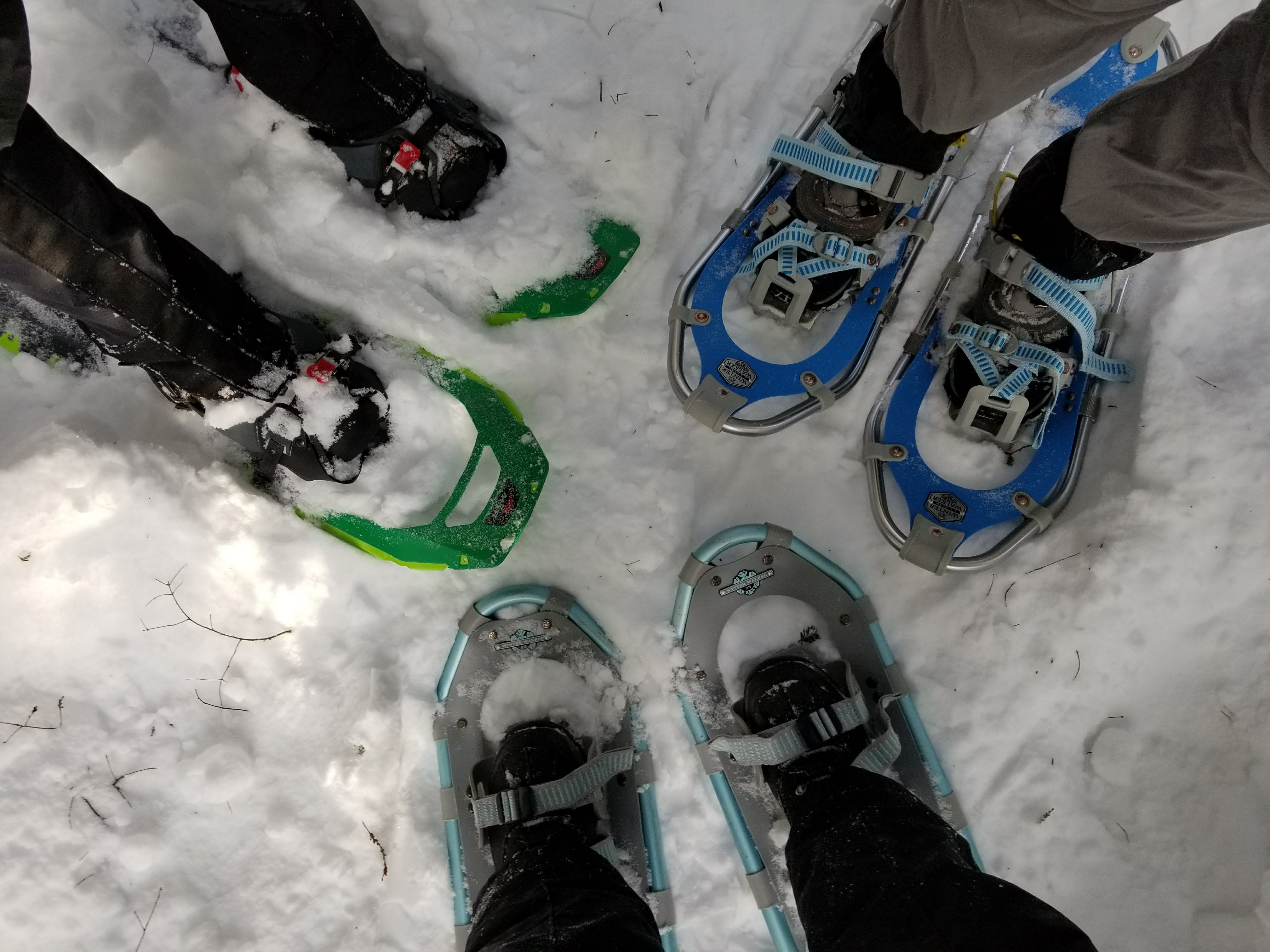
The length of your snowshoe is dictated by your body weight. If you’re renting, the outfitter will help make sure you’ve got the right size. If you’re buying or borrowing from a friend, look up the correct size for your weight online or check the sizing chart on the snowshoes. Nearly all snowshoes are designed to strap right over your winter boot (waterproof winter boots are best for adventures like this).
If you'd like to try snowshoeing out before you invest, look to local outfitters for rentals, which are often offered by the day or week. You can also check your local library - some have snowshoes to lend to members. The Katahdin Gear Library at the Millinocket Memorial Library has snowshoes that members can check out for free - and anyone can become a member. Some trail systems in the Maine Highlands have snowshoes to rent on site, like Penobscot River Trails, which has snowshoes available to rent by donation on weekends.
As for apparel, layers are key. Wear wool or synthetic fabrics. Snow pants can be a good idea, especially if you’re moving at a mellow pace and not likely to get too hot. Don’t forget those mittens and a hat. Some people also like to snowshoe with poles.
Once your snowshoes are strapped onto your feet and you’re appropriately bundled for the winter conditions, you’re off! That’s it!
Where to go Local trails transform when the snow falls, and snowshoeing is a wonderful - and family-friendly - way to get out into it. Head over to your favorite local trail to see how things look this time of year. Local land trusts and chambers are excellent resources to learn about easy-going trails in your town or when you're venturing farther from home. Websites like mainetrailfinder.com allow you to search a specific region based on your activity and the length and level of difficulty of the trail.
Find stellar beginner-friendly trails at Penobscot River Trails in Grindstone, Bangor City Forest and Bangor Municipal Golf Course in Bangor, Hirundo Wildlife Refuge in Old Town and the Lagrange to Medford Trail.
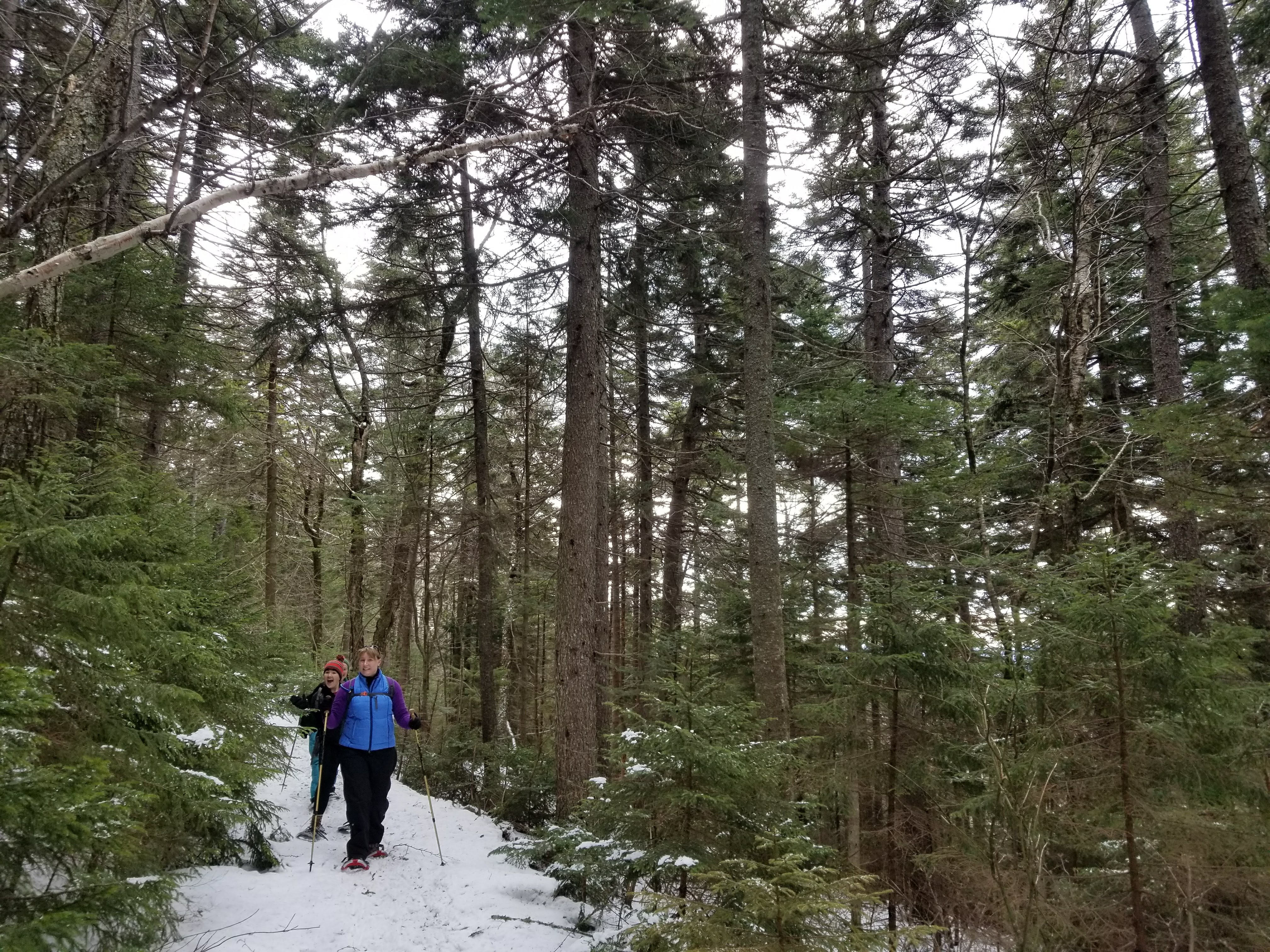
Cross-Country Skiing Cross-country skiing takes a little longer to learn. Moving around with long skis on your feet takes some getting used to and finding your stride comes with practice. Taking a lesson is helpful and will help you learn the basics about the kick and glide, good form, and how to get up after a tumble. (Tumbles will happen. Even those confident skiers you spot on the trails first spent a handful of afternoons clumsily practicing their balance, learning how to glide, and falling on their keisters.)
But it’s also a-okay to head out on your own and give it a go (we recommend finding a nice flat trail to start. Save those hills for later). There are videos on YouTube that can provide some helpful pointers before you go.
Gearing up
Like snowshoes, cross-country skis come in a few different styles that are suited to different approaches to the sport. There are classic skis, skate skis, and backcountry skis. If you're new to cross-country and looking to ski on groomed and/or well-established trails, get classic skis. This style of skiing keeps your skis parallel as you slide one leg forward and then the other, either in established tracks or on packed or shallow snow. Skate skiing is a more challenging style where your skis function more like ice skates. And backcountry is, well, backcountry.

When renting, many local outfitters rent both classic and skate skis. Classic is easier to learn and a good place to begin. Ski length is based on your height, and wherever you rent from will help you select the right skis, boots, and poles for your size.
If you're buying, look online to see which length is appropriate for you or ask someone in the shop. Note: Cross-country skis have bindings that fit specific boots. The most popular these days are NNN and SNS styles. Make sure both your boots and your ski bindings are the same style.
Cross-country skiing gets your whole body moving, which means you’re more likely to work up a sweat in the process. Lighter layers are better in those cases. A backpack with water and snacks is handy, and a nice place to stuff layers as you take them off.
Where to go When you’re ready to get moving, there are lots of resources to help you locate beginner-friendly terrain. Websites like mainetrailfinder.com allow you to search a specific region based on your activity and the length and level of difficulty of the trail. There are also Facebook groups like “Maine Cross-Country Skiing,” and "Friends of A Fierce Chase Cross Coutnry Ski Trails" in Monson, where skiers post recent adventures and trail conditions. It’s a great way to get ideas of where to go or even ask questions.
You can also check the social media pages and websites of the local trail systems to find trail conditions. For great local knowledge, inquire with the local chambers and land trusts in your area or wherever you're visiting. They’ll know right where to go.
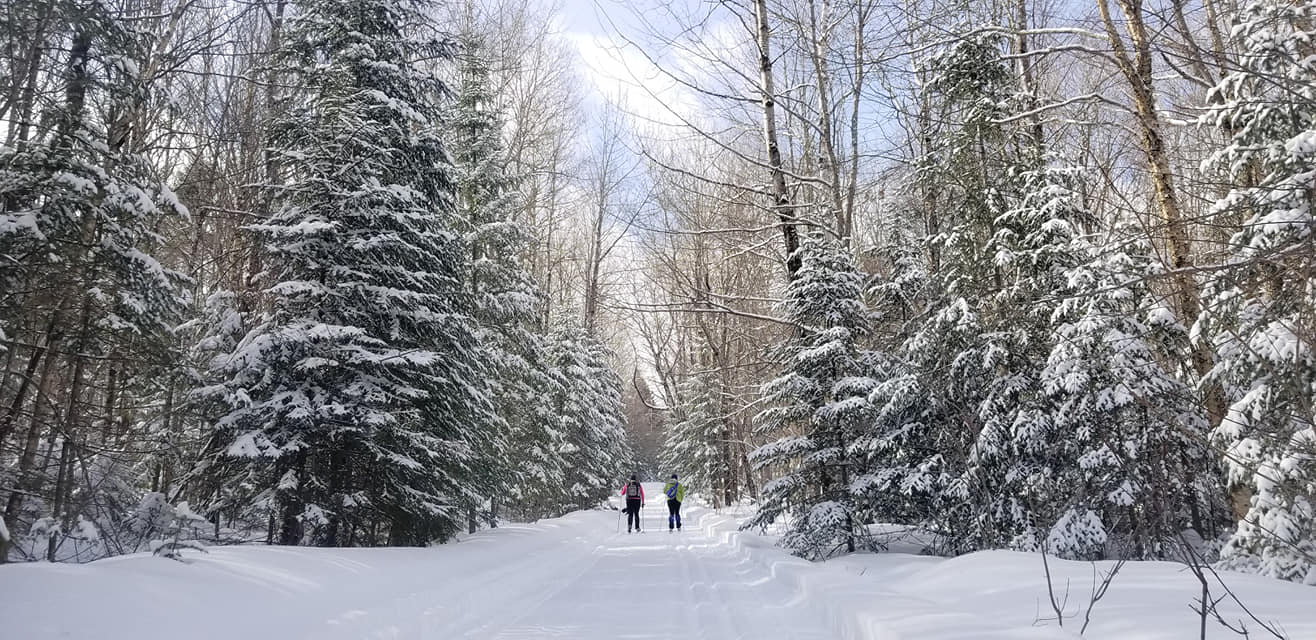
In the Maine Highlands, some cool ski spots include Penobscot River Trails in Grindstone, the New England Outdoor Center in Millinocket, The Birches Resort in Rockwood, Bangor City Forest in Bangor, Caribou Bog Ski Trail in Orono, and Barnes Brook XC Ski Center in West Enfield.
This IS going to be the year you enjoy all winter has to offer. Whether on skis or in snowshoes, you'll make memories, explore new places, and have the grandest time.
Helpful Resources: Check with your local library to see if they have outdoor gear like snowshoes to check out. The Katahdin Gear Library at the Millinocket Memorial Library has snowshoes and cross-country skis to lend to members, and anyone can become a member. You don’t have to live in Millinocket.
Used outdoor gear shops may have snowshoes and cross-country equipment for sale. Craigslist and Facebook Marketplace are good places to look as well.
Area outfitters, like Ski Rack Sports and Epic Sports in Bangor, sell new gear and also rent snowshoes by the day or week.
New England Outdoor Center in Millinocket boasts nearly 16 miles of groomed XC Ski trails on Hammond Ridge with views of Mount Katahdin, Millinocket Lake, Ambajejus Lake and Jo-Mary Mountain. Both snowshoe and cross-country ski rentals are available.
The Birches Resort in Rockwood has more than 40 miles of groomed trails departing from their location on Moosehead Lake. Trails range in difficulty from novice to high intermediate. Cross-country ski rentals are also available.
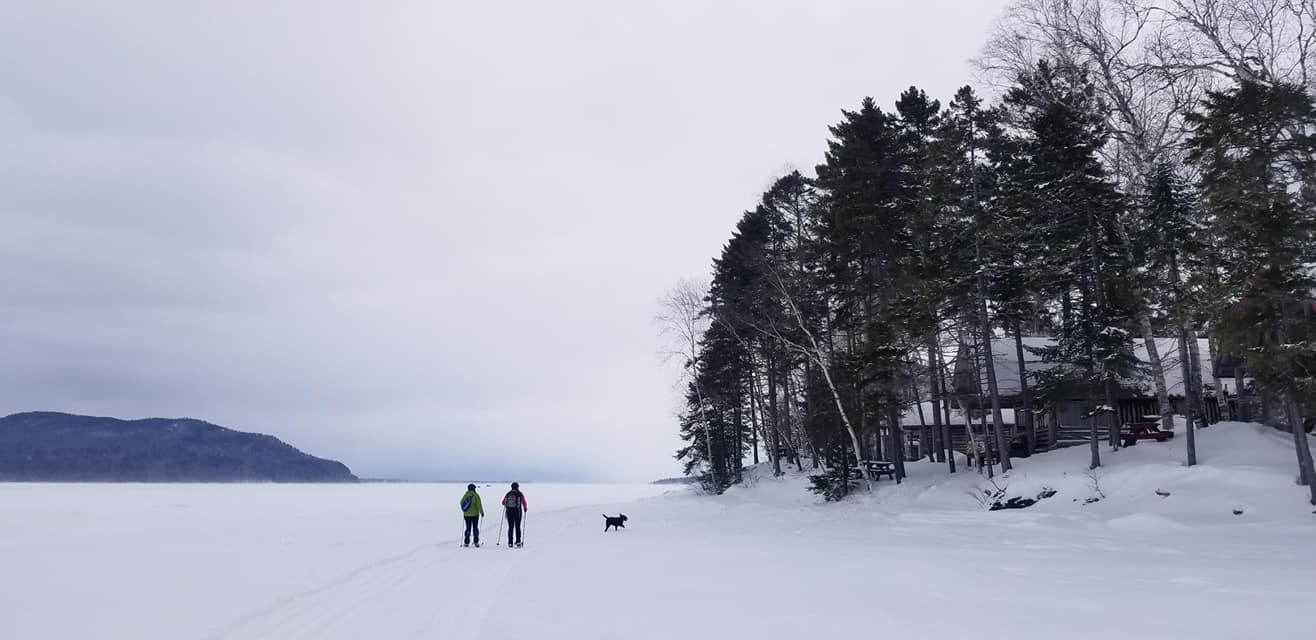 Penobscot River Trails in Grindstone has 16 miles of groomed trails along the East Branch of the Penobscot River. Cross-country skis and snowshoes are available to rent by donation on weekends, when the visitor's center is open.
Penobscot River Trails in Grindstone has 16 miles of groomed trails along the East Branch of the Penobscot River. Cross-country skis and snowshoes are available to rent by donation on weekends, when the visitor's center is open.
The Bangor City Forest has nearly 20 miles of trails, including groomed cross-country skiing trails and snowshoeing trails. Terrain ranges from easy to moderate. The Bangor Municipal Golf Course is also great for skiing and snowshoeing on easy-going terrain.
The Lagrange to Medford Trail is 16 miles one way and passes through forests and farmland. This multi-use trail is open to snowshoeing, cross-country skiing, as well as ATVs, dog-sledding, and horseback riding.
Online Resources:
A Fierce Chase Cross Country Ski Trails Facebook Group
mainetrailfinder.com
stepoutside.org
TrailLink
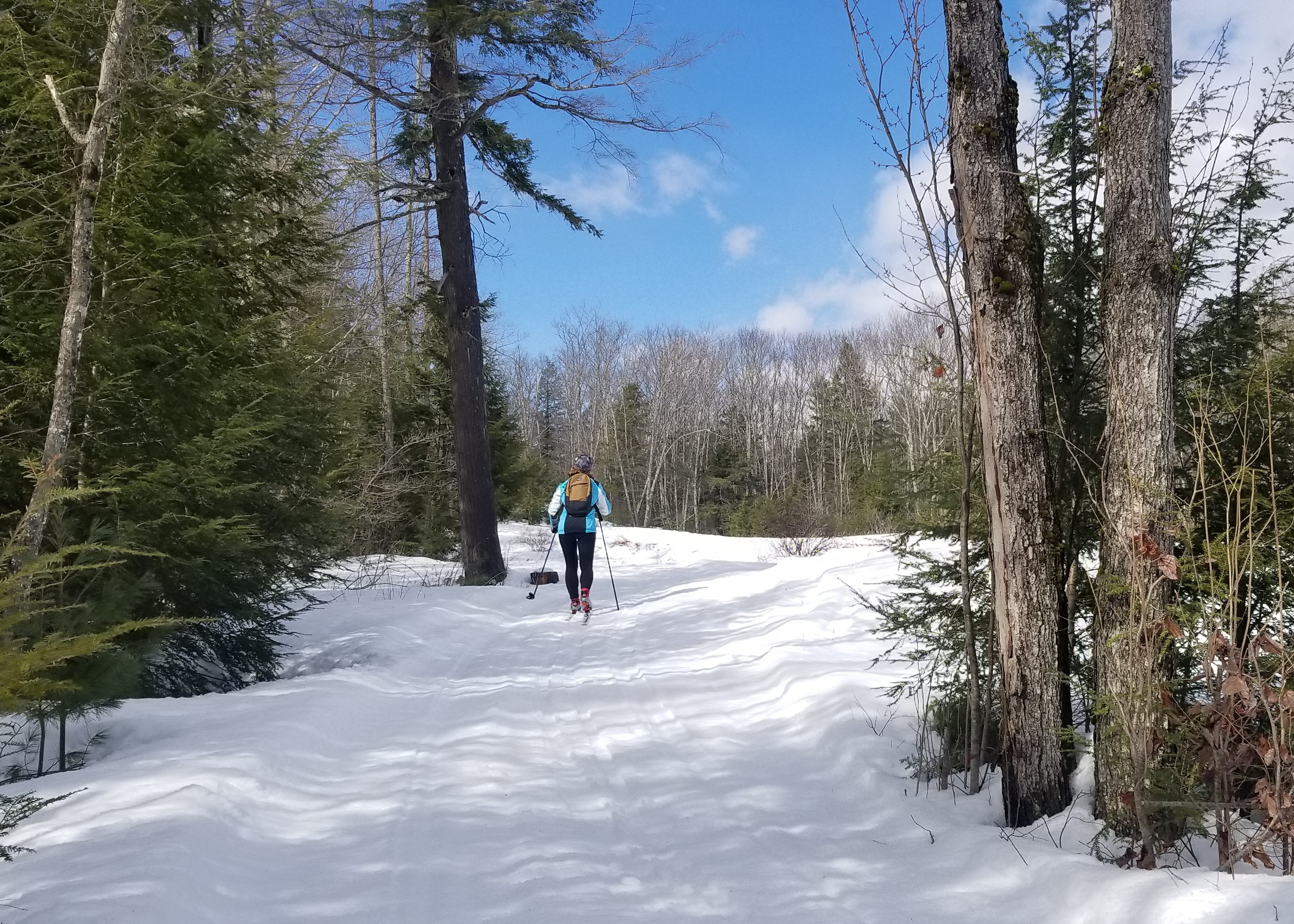 Article and photos courtesy of Shannon Bryan, FitMaine
Article and photos courtesy of Shannon Bryan, FitMaine




